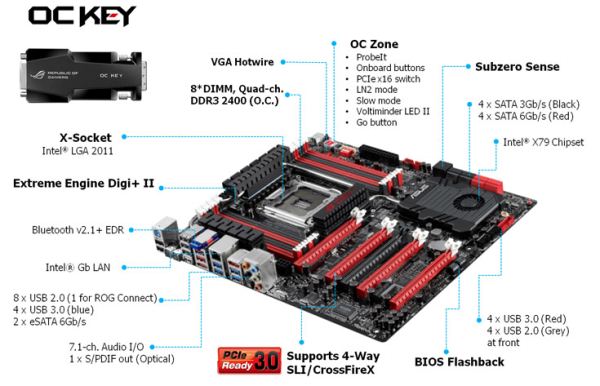ASUS Republic of Gamers and X79 ROG Review – Rampage IV Gene, Formula and Extreme
by Ian Cutress on August 3, 2012 1:00 PM EST- Posted in
- Motherboards
- Asus
- X79
- ROG
Rampage IV Extreme Conclusions
Halo products are big news and big business. If your product is the best, and everyone says it is the best, then those that ask will get your product as the answer. As a result, the person who asked may then go out and purchase one of your products. The downside of a Halo product is that it requires a lot of time and investment - lots of research and development that may not pay off if another company jumps ahead of you. Chances are as well that due to all that investment, the halo product itself will not even break even. However, you are hoping that it will filter down to the regular products and boost their sales.
I should stress that the halo product is different to the 'ultimate' product. The halo product only has to beat the competition to be number one, rather than cater for every single need in every single category. There are many examples of this in the history of motherboards where particular companies have placed on their products a variety of superfluous functionality that means nothing to most people, often at great expense.
With the ROG brand, and particularly with the Rampage IV Extreme, the prize is the Halo effect. In the minds of ASUS, they needed a product that would achieve the pinnacle of performance, whilst still being a great board to manipulate. This is why they hired, inter alia, Andre Yang and Peter 'Shamino' Tan on to the team - two of the world's best overclockers, in order to invest time into improving the range of ROG products.
Performance wise, it is hard to stop the Extreme it its tracks - as with all the other ROG motherboards in this review, the MultiCore Enhancement at stock means that out of the packet, this X79 board is one of the best performing on the market. If we couple that with some other hardware and nice overclocks, we can break records, or with some sub-zero cooling, world records for performance. The features on board to aid this are also numerous: VGA Hotwire useful for GPU overclocking; the enhanced LN2 mode gives the already substantial BIOS a kick in the rear; SubZero Sense removes the need for thermometers; and the added OC Key is a marvelous piece of technology to allow the enthusiast to view and adjust values on the fly.
To be the best, you have to perform the best. If you have enough green in your wallet, then the Rampage IV Extreme will offer you that base of performance from which to launch any world record attempt. While it may not be for everyone (regular users would prefer the Gene or Formula), as an overclocker we can tweak the RIVE to our hearts content.
At $430, double the price of the ASRock X79 Extreme4-M, is the Rampage IV Extreme a good buy? Compared to the 4-M, the RIVE feels like more than double the board, in terms of features and performance. Let us not forget, users of the RIVE may also be spending $999 on a processor, so there would be good reason to pair it with a board more geared to deal with the power and price is probably not an issue.
With all this in mind, I would like to give the Extreme an AnandTech Editors' Choice Silver Award. If your usage scenario is power, and you want an array of tools in order to take down the best scores of a CPU generation, then the Rampage IV Extreme is the best tool to do it with should money be no object.

ASUS Rampage IV Extreme
Silver Award











34 Comments
View All Comments
Flunk - Friday, August 3, 2012 - link
Ivy Bridge is more of a notebook oriented update anyway. The much better integrated graphics don't really matter to us anyway.G-Man - Friday, August 3, 2012 - link
Fantastic article, Ian! You must have been working on this for a long time. Thanks for a great read.B - Friday, August 3, 2012 - link
Ian -I would like to point out that under that nice metal Creative X-FI chip badge is, in fact, a Realtek processor. The Soundblaster piece of this is a merely a software implementation. I have this motherboard and was quite disappointed to discover this.
Thanks for great and thorough article.
just4U - Friday, August 3, 2012 - link
Indeed.. It's a little bit of a letdown. It will be nice if they are pushed away from the realtek chip now that Gigabyte is into similiar type boards which utilize the Creative recon chips.primonatron - Friday, August 3, 2012 - link
The article should be edited to specificy that it's only a Relatek chip, not a Creative one, at this point it's just blatent false advertising.When doing the review, did Anandtech actually do a Windows 7 install on it themselves?
They would have known if they did.
IanCutress - Friday, August 3, 2012 - link
As per my comment above, it states this in the tenth page. And yes, I do install Windows 7 fresh on every board I test. It would be crazy not to. I see the whole install procedure at least twice a week, as well as installing each vendors drivers and software. The ASUS install procedure for drivers is all one-button automatic, no user input required, no giant screens flashing up on the screen to ask to confirm this that or the other.Ian
primonatron - Friday, August 3, 2012 - link
I would not put " ASUS have dug into their pockets to provide the Gene with a better-than-Realtek solution, in the SupremeFX III" since it IS a Realtek solution.IanCutress - Friday, August 3, 2012 - link
Written in page 10:"In our SupremeFX III, we essentially get a Realtek codec (presumed ALC898), but by being stage III this chip is isolated from the rest of the board, has a separate EMI shield around the chip, its own PCB layer for audio tracing, a 1500 mF capacitor to reduce ripple, and gold plated audio jacks to minimize resistance. As a result, the SNR is increased to 110dB."
Ian
just4U - Saturday, August 4, 2012 - link
It also needs to be noted that soundchips getting decent software can be a fairly substantial bump.. atleast from my point of view. I seem to recall Creative nailing a company to the wall because they used software the emulated soundblaster stuff and they were reall popular 7 years back.just4U - Friday, August 3, 2012 - link
I've been using these for several years... and have always found that they offer more then most standard ATX boards in lesser and similiar price ranges. Your not paying the Big bucks but you have your foot in the door.. (as it were.. lol)They can be problematic at times mind you.. I've found that quality control can be a bit of an issue with dead boards coming in now and again. We are dealing with sensitive electronics mind you so that happens.
I must say they do have some competition now with Gigabyte's M3s sniper boards, that do utilize a true recon3d sound chip from Creative (as opposed to a realtek chip with software emulation). My hope is that it pushes Asus towards a similiar move as the sound is a key feature for these baby boards.
Personally I think the Gene series deserves your silver award. While high end boards can be had from all makers getting a good solid feature rich gaming MATX board is not the norm and they are almost allways a pleasure to work with.
Great review Ian.